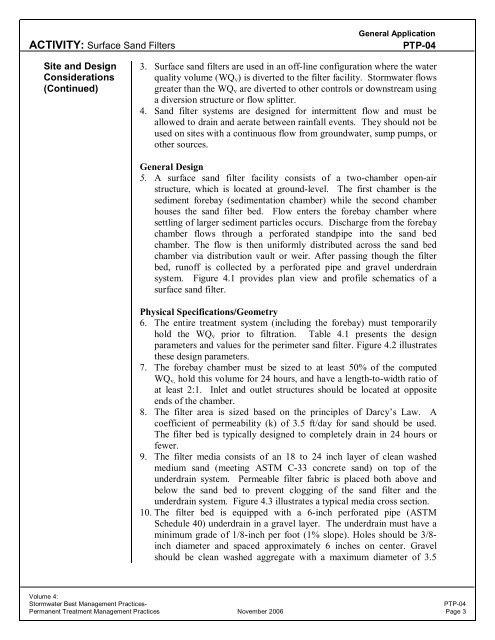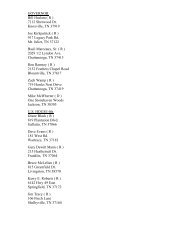Surface Sand Filters PTP-04 - City of Franklin
Surface Sand Filters PTP-04 - City of Franklin
Surface Sand Filters PTP-04 - City of Franklin
Create successful ePaper yourself
Turn your PDF publications into a flip-book with our unique Google optimized e-Paper software.
General Application<br />
ACTIVITY: <strong>Surface</strong> <strong>Sand</strong> <strong>Filters</strong> <strong>PTP</strong>-<strong>04</strong><br />
Site and Design<br />
Considerations<br />
(Continued)<br />
3. <strong>Surface</strong> sand filters are used in an <strong>of</strong>f-line configuration where the water<br />
quality volume (WQv) is diverted to the filter facility. Stormwater flows<br />
greater than the WQv are diverted to other controls or downstream using<br />
a diversion structure or flow splitter.<br />
4. <strong>Sand</strong> filter systems are designed for intermittent flow and must be<br />
allowed to drain and aerate between rainfall events. They should not be<br />
used on sites with a continuous flow from groundwater, sump pumps, or<br />
other sources.<br />
General Design<br />
5. A surface sand filter facility consists <strong>of</strong> a two-chamber open-air<br />
structure, which is located at ground-level. The first chamber is the<br />
sediment forebay (sedimentation chamber) while the second chamber<br />
houses the sand filter bed. Flow enters the forebay chamber where<br />
settling <strong>of</strong> larger sediment particles occurs. Discharge from the forebay<br />
chamber flows through a perforated standpipe into the sand bed<br />
chamber. The flow is then uniformly distributed across the sand bed<br />
chamber via distribution vault or weir. After passing though the filter<br />
bed, run<strong>of</strong>f is collected by a perforated pipe and gravel underdrain<br />
system. Figure 4.1 provides plan view and pr<strong>of</strong>ile schematics <strong>of</strong> a<br />
surface sand filter.<br />
Physical Specifications/Geometry<br />
6. The entire treatment system (including the forebay) must temporarily<br />
hold the WQv prior to filtration. Table 4.1 presents the design<br />
parameters and values for the perimeter sand filter. Figure 4.2 illustrates<br />
these design parameters.<br />
7. The forebay chamber must be sized to at least 50% <strong>of</strong> the computed<br />
WQv, hold this volume for 24 hours, and have a length-to-width ratio <strong>of</strong><br />
at least 2:1. Inlet and outlet structures should be located at opposite<br />
ends <strong>of</strong> the chamber.<br />
8. The filter area is sized based on the principles <strong>of</strong> Darcy’s Law. A<br />
coefficient <strong>of</strong> permeability (k) <strong>of</strong> 3.5 ft/day for sand should be used.<br />
The filter bed is typically designed to completely drain in 24 hours or<br />
fewer.<br />
9. The filter media consists <strong>of</strong> an 18 to 24 inch layer <strong>of</strong> clean washed<br />
medium sand (meeting ASTM C-33 concrete sand) on top <strong>of</strong> the<br />
underdrain system. Permeable filter fabric is placed both above and<br />
below the sand bed to prevent clogging <strong>of</strong> the sand filter and the<br />
underdrain system. Figure 4.3 illustrates a typical media cross section.<br />
10. The filter bed is equipped with a 6-inch perforated pipe (ASTM<br />
Schedule 40) underdrain in a gravel layer. The underdrain must have a<br />
minimum grade <strong>of</strong> 1/8-inch per foot (1% slope). Holes should be 3/8-<br />
inch diameter and spaced approximately 6 inches on center. Gravel<br />
should be clean washed aggregate with a maximum diameter <strong>of</strong> 3.5<br />
Volume 4:<br />
Stormwater Best Management Practices- <strong>PTP</strong>-<strong>04</strong><br />
Permanent Treatment Management Practices November 2006 Page 3




